Page 83 of 354
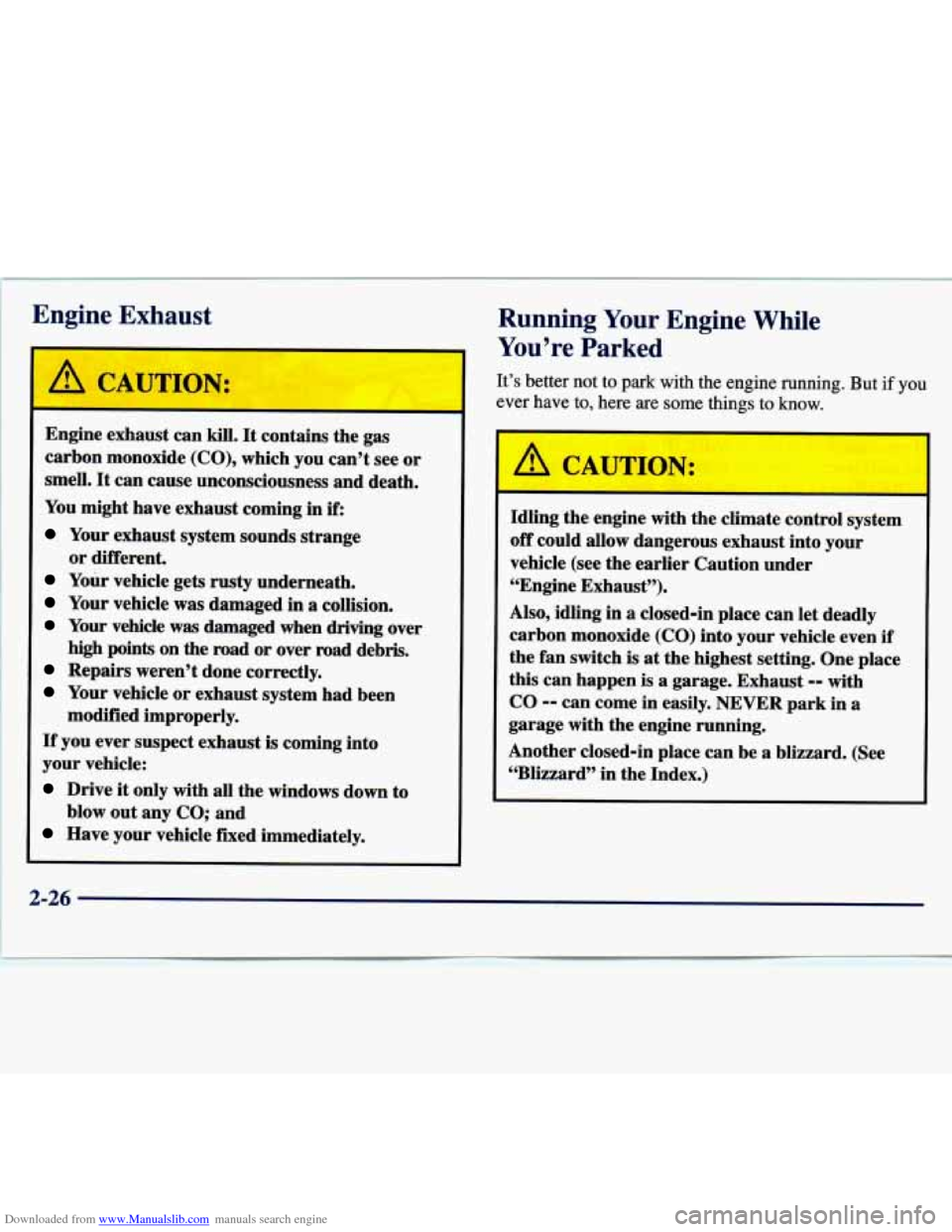
Downloaded from www.Manualslib.com manuals search engine Engine Exhaust
Running Your Engine While
t
L
A CAUTION:
Engine exhaust can kill. It contains the gas
carbon monoxide (CO), which you can’t see or
I
smell. It can cause unconsciousness and death.
You might have exhaust coming in if:
Your exhaust system sounds strange
Your vehicle gets rusty underneath.
Your vehicle was damaged in a collision.
Your vehicle was damaged when driving over
high
points on the road or over road debris.
Repairs weren’t done correctly.
Your vehicle or exhaust system had been
If you ever suspect exhaust is coming into
your vehicle:
Drive it only with all the windows down to
Have your vehicle fixed immediately.
or different.
modified improperly.
blow out any CO; and
You’re Parked
It’s better not to park with the engine running. But if you
ever Ple to, here are some things to know.
’ 4 CAUdON:
Idling the engine with the climate control system
off could allow dangerous exhaust into your
vehicle (see the earlier Caution under
“Engine Exhaust”).
Also, idling in a closed-in place can let deadly
carbon monoxide
(CO) into your vehicle even if
the fan switch is at the highest setting. One place
this can happen is a garage. Exhaust
-- with
CO
-- can come in easily. NEVER park in a
garage with the engine running.
Another closed-in place can be a blizzard. (See
“Blizzard” in the Index.)
Page 84 of 354
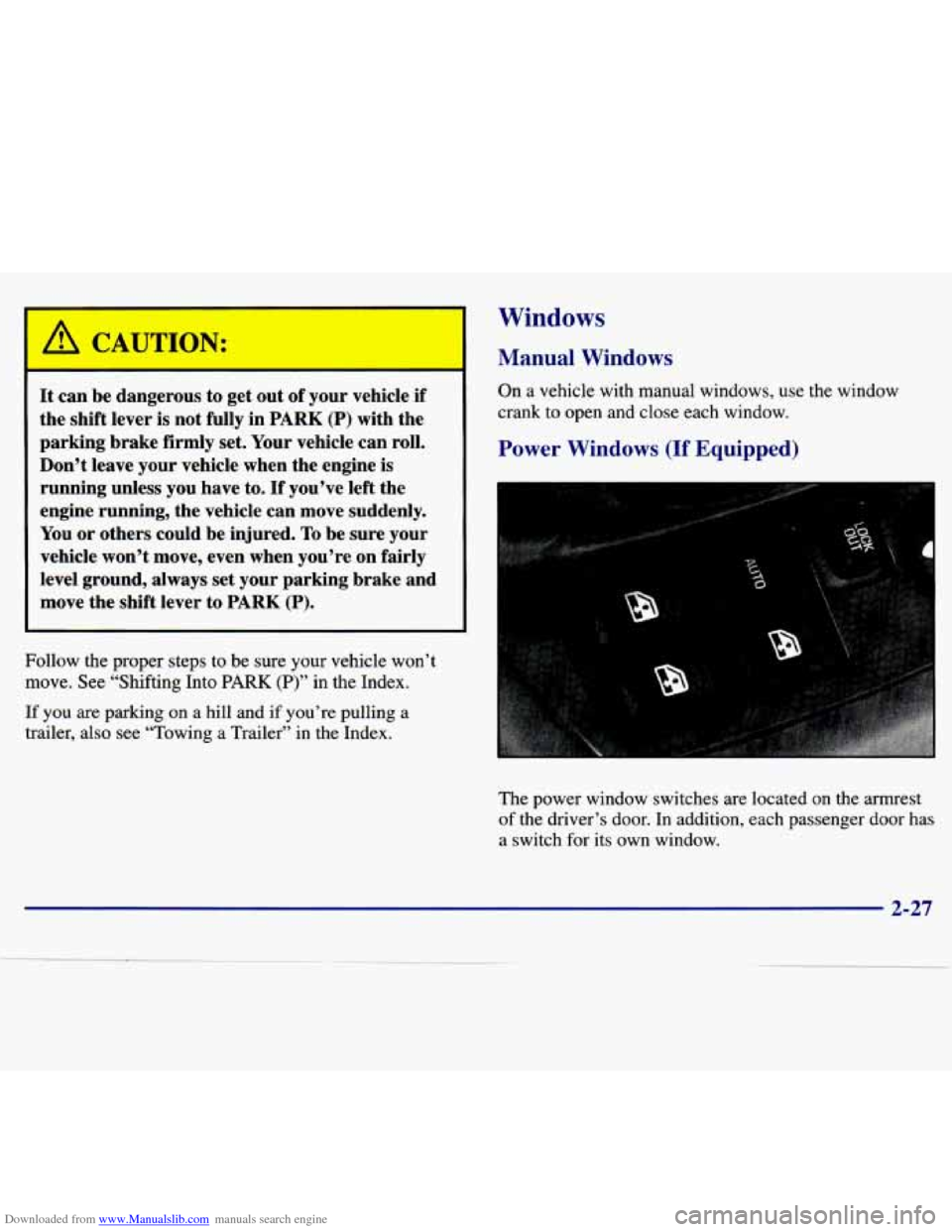
Downloaded from www.Manualslib.com manuals search engine It can be dangerous to get out of your vehicle if
the shift lever is not fully in
PARK (P) with the
parking brake firmly set. Your vehicle can roll.
Don’t leave your vehicle when the engine
is
running unless you have to. If you’ve left the
engine running, the vehicle can move suddenly.
You or others could be injured.
To be sure your
vehicle won’t move, even when you’re on fairly
level ground,
always set your parking brake and
move the shift lever
to PARK (P).
Windows
Manual Windows
On a vehicle with manual windows, use the window
crank to open and close each window.
Power Windows (If Equipped)
Follow the proper steps to be sure your vehicle won’t move. See “Shifting Into
PARK (P)” in the Index.
If you are parking on a hill and if you’re pulling a
trailer,
also see “Towing a Trailer” in the Index.
The power window switches are located on the amest
of the driver’s door.
In addition, each passenger door has
a switch for its own window.
2-27
Page 85 of 354
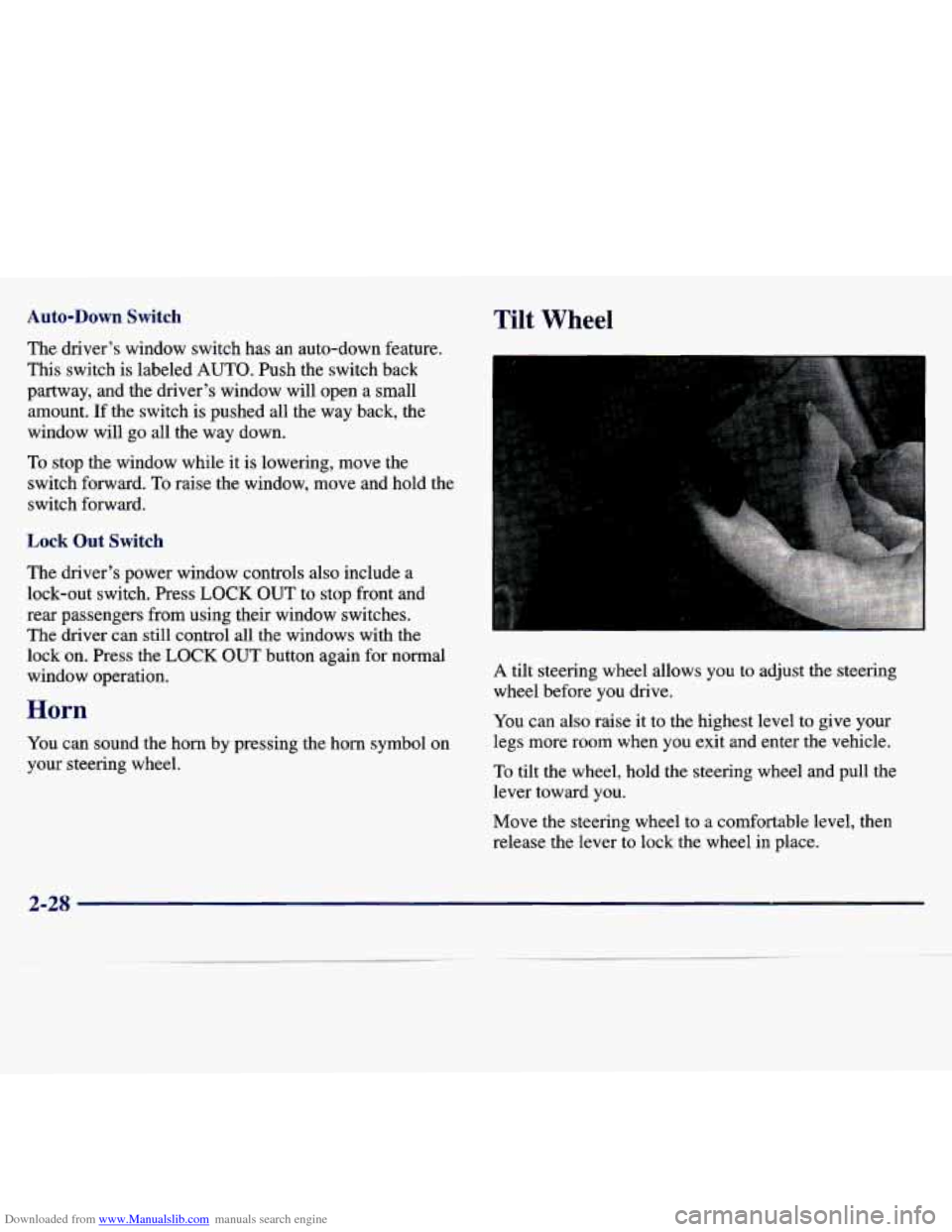
Downloaded from www.Manualslib.com manuals search engine Auto-Down Switch Tilt Wheel
The driver’s window switch has an auto-down feature.
This switch is labeled AUTO. Push the switch back
partway, and the driver’s window will open
a small
amount. If the switch
is pushed all the way back, the
window will
go all the way down.
To stop the window while it is lowering, move the
switch forward.
To raise the window, move and hold the
switch forward.
Lock Out Switch
The driver’s power window controls also include a
lock-out switch. Press
LOCK OUT to stop front and
rear passengers from using their window switches.
The driver
can still control all the windows with the
lock on. Press the
LOCK OUT button again for normal
window operation.
Horn
You can sound the horn by pressing the horn symbol on
your steering wheel.
A tilt steering wheel allows you to adjust the steering
wheel before you drive.
You can also raise it to the highest level to give your
legs more room when you exit and enter the vehicle.
To tilt the wheel, hold the steering wheel and pull the
lever toward you.
Move the steering wheel to a comfortable level, then
release the lever
to lock the wheel in place.
2-2s
Page 97 of 354
Downloaded from www.Manualslib.com manuals search engine Mirrors
Inside Daymight Rearview Mirror
This mirror can be adjusted two ways. First, to adjust
the angle of the mirror, move the mirror to a position
that allows you see out the back window.
To adjust the
height of the mirror, adjust the
arm that connects the
mirror to the windshield.
To reduce glare from lights behind you, move the lever
toward you to the night position.
Manual Remote Control Mirror
The outside rearview mirror should be adjusted so you
can just see the side
of your vehicle when you are sitting
in a comfortable driving position.
Adjust the driver’s side outside mirror with the
control lever on the
driver’s door.
To adjust your passenger’s side mirror, sit in the driver’s
seat and have a passenger adjust the mirror for you.
2-40
Page 100 of 354
Downloaded from www.Manualslib.com manuals search engine Instrument Panel Cupholder
The instrument panel cupholder is located to the left of
the steering wheel.
To use it, pull it out until the rubber
insert
is revealed. The insert is removable for easy
cleaning.
To clean it, use spray window cleaner.
Center Console Cupholder
The console provides space for holding a cup or soft
drink container. The cupholder is located
at the rear of
the shifter.
Rear Seat Cupholder
Pull down the door on the rear of the center console to
use the rear seat cupholder. You can use it to hold cups
or juice boxes.
2-43
Page 122 of 354
Downloaded from www.Manualslib.com manuals search engine U Section 3 Comfort Controls and Audio Systems
In this section, you'll find out how to operate the comfort control and audio systems offered with your Chevrolet. Be
sure to read about the particular systems supplied with your vehicle.
3-2
3-2
3-4
3-4
3-5
3-6
3-7
3-7
3-9 3-13 Climate Controls
Air Conditioning
Heating
Tips for Defogging and Defrosting
Rear Window Defogger
Ventilation System and Tips Setting the Clock
A" Stereo
A" Stereo with Cassette and ATC
CD Adapter Kits
3- 14
3-18
3- 19
3-22
3-22
3-22 3-23
3-24
3-24 A" Stereo with CD and ATC
Remote Cassette Player
Theft-Deterrent Feature
Adding Sound Equipment to Your Vehicle
Understanding Radio Reception Tips About Your Audio System
Care of Your Cassette Tape Player
Care of Your Compact Discs
Antenna
3-1
Page 125 of 354
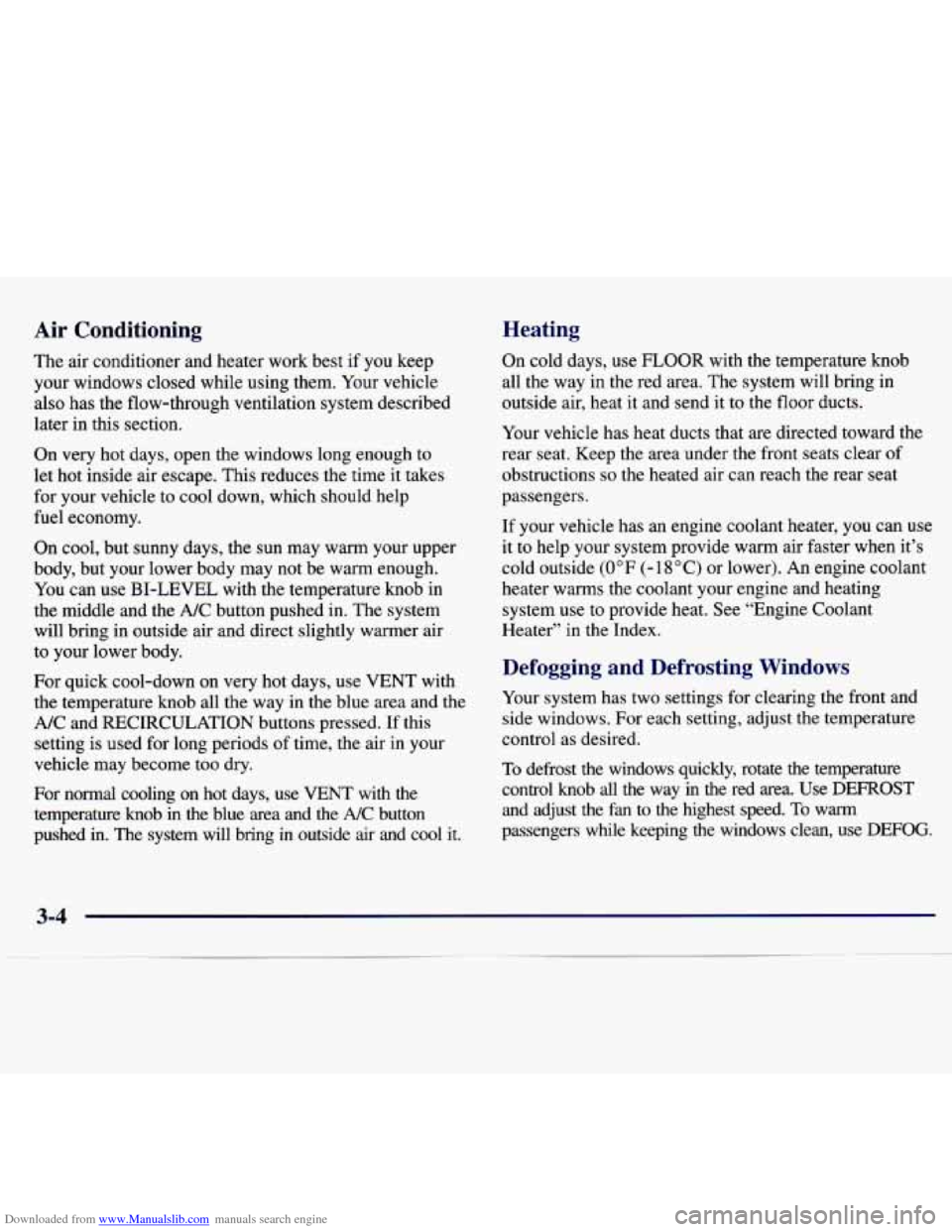
Downloaded from www.Manualslib.com manuals search engine Air Conditioning Heating
On cold
days, use FLOOR with the temperature knob
all the way in the red area. The system will bring in
outside air, heat it and send it to the floor ducts.
The
air conditioner and heater work best if you keep
your windows closed while using them. Your vehicle also has the flow-through ventilation system described
later in this section.
On very hot days, open the windows long enough to
let hot inside air escape. This reduces the time it takes
for your vehicle to cool down, which should help
fuel economy.
On cool, but sunny days, the sun may warm your upper
body, but your lower body may not be
warm enough.
You can use
BI-LEVEL with the temperature knob in
the middle and the A/C button pushed in. The system
will bring in outside air and direct slightly warmer air
to your lower body.
For quick cool-down on very hot days, use
VENT with
the temperature knob all the way in the blue area and the
A/C and RECIRCULATION buttons pressed. If this
setting is used for long periods of time, the air in your
vehicle may become too dry.
For normal cooling on hot days, use
VENT with the
temperature knob in the blue area and the
NC button
pushed
in. The system will bring in outside air and cool it.
Your vehicle has heat ducts that are directed toward the
rear seat. Keep the area under the front seats clear
of
obstructions so the heated air can reach the rear seat
passengers.
If your vehicle has an engine coolant heater, you can use it to help your system provide warm air faster when it’s
cold outside
(0°F (-18°C) or lower). An engine coolant
heater warms the coolant your engine and heating system use to provide heat. See “Engine Coolant
Heater” in the Index.
Defogging and Defrosting Windows
Your system has two settings for clearing the front and
side windows. For each setting, adjust the temperature
control as desired.
To defrost the windows quickly, rotate the temperature control knob
all the way in the red area. Use DEFROST
and adjust the fan to the highest speed. To warm
passengers while keeping the windows clean, use DEFOG.
3-4
Page 126 of 354
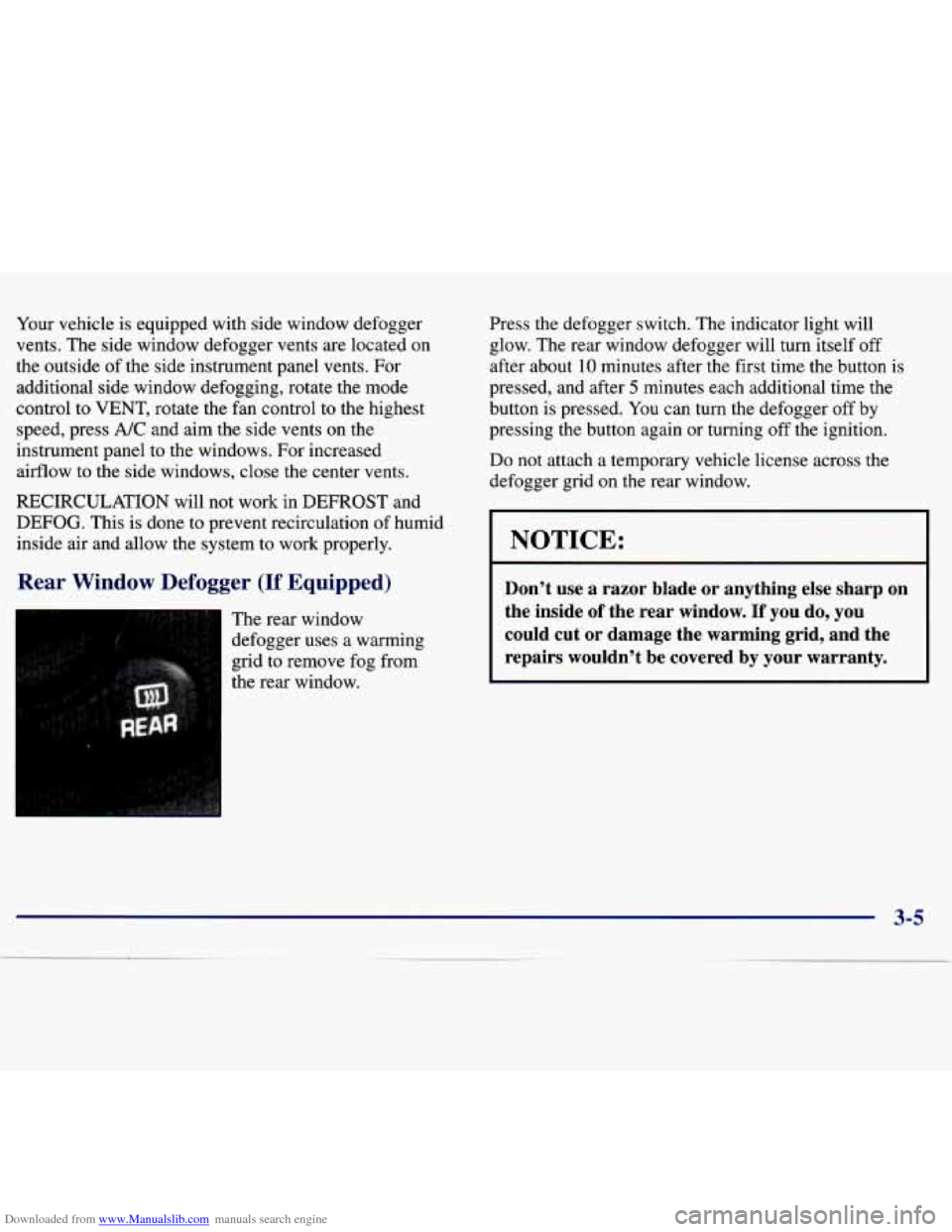
Downloaded from www.Manualslib.com manuals search engine Your vehicle is equipped with side window defogger
vents. The side window defogger vents are located on
the outside of the side instrument panel vents. For
additional side window defogging, rotate the mode
control to VENT, rotate the fan control to the highest
speed, press
A/C and aim the side vents on the
instrument panel to the windows. For increased
airflow to the side windows, close the center vents.
RECIRCULATION will not work in DEFROST and
DEFOG. This is done to prevent recirculation of humid
inside air and allow the system to work properly.
Rear Window Defogger (If Equipped)
I The rear window
defogger uses a warming
grid to remove fog from
the rear window. Press the defogger switch.
The indicator light will
glow. The rear window defogger will turn itself
off
after about 10 minutes after the first time the button is
pressed, and after
5 minutes each additional time the
button is pressed. You can turn the defogger off
by
pressing the button again or turning off the ignition.
Do not attach a temporary vehicle license across the
defogger grid on the rear window.
NOTICE:
Don’t use a razor blade or anything else sharp on
the inside
of the rear window. If you do, you
could cut or damage the warming grid, and the repairs wouldn’t be covered by your warranty.
3-5